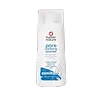What's inside
What's inside
 Key Ingredients
Key Ingredients

 Benefits
Benefits

 Concerns
Concerns

No concerns
 Ingredients Side-by-side
Ingredients Side-by-side

Water
Skin ConditioningSodium Cocoyl Isethionate
CleansingDecyl Glucoside
CleansingCoco-Glucoside
CleansingPropanediol
SolventGlycerin
HumectantMoringa Oleifera Seed Extract
Skin ConditioningCitrus Limon Fruit Oil
AstringentPassiflora Edulis Seed Oil
EmollientGlycine Soja Oil
EmollientTocopherol
AntioxidantGlyceryl Oleate
EmollientCitric Acid
BufferingHydrogenated Palm Glycerides Citrate
EmollientCoconut Acid
CleansingSodium Isethionate
CleansingBentonite
AbsorbentXanthan Gum
EmulsifyingLevulinic Acid
PerfumingSodium Levulinate
Skin ConditioningP-Anisic Acid
MaskingParfum
MaskingCharcoal Powder
AbrasiveTitanium Dioxide
Cosmetic ColorantMagnesium Myristate
Menthol
MaskingLeuconostoc/Radish Root Ferment Filtrate
AntimicrobialWater, Sodium Cocoyl Isethionate, Decyl Glucoside, Coco-Glucoside, Propanediol, Glycerin, Moringa Oleifera Seed Extract, Citrus Limon Fruit Oil, Passiflora Edulis Seed Oil, Glycine Soja Oil, Tocopherol, Glyceryl Oleate, Citric Acid, Hydrogenated Palm Glycerides Citrate, Coconut Acid, Sodium Isethionate, Bentonite, Xanthan Gum, Levulinic Acid, Sodium Levulinate, P-Anisic Acid, Parfum, Charcoal Powder, Titanium Dioxide, Magnesium Myristate, Menthol, Leuconostoc/Radish Root Ferment Filtrate
Water
Skin ConditioningDecyl Glucoside
CleansingXanthan Gum
EmulsifyingBambusa Arundinacea Stem Extract
Skin ConditioningCanarium Luzonicum Gum Nonvolatiles
MaskingCitrus Aurantium Dulcis Peel Oil
MaskingLuffa Cylindrica Fruit Powder
AbrasiveCoco-Glucoside
CleansingGlyceryl Oleate
EmollientHydrogenated Palm Glycerides Citrate
EmollientTocopherol
AntioxidantCitric Acid
BufferingGluconolactone
Skin ConditioningCalcium Gluconate
HumectantCI 77288
Cosmetic ColorantSodium Benzoate
MaskingWater, Decyl Glucoside, Xanthan Gum, Bambusa Arundinacea Stem Extract, Canarium Luzonicum Gum Nonvolatiles, Citrus Aurantium Dulcis Peel Oil, Luffa Cylindrica Fruit Powder, Coco-Glucoside, Glyceryl Oleate, Hydrogenated Palm Glycerides Citrate, Tocopherol, Citric Acid, Gluconolactone, Calcium Gluconate, CI 77288, Sodium Benzoate
 Reviews
Reviews

Ingredients Explained
These ingredients are found in both products.
Ingredients higher up in an ingredient list are typically present in a larger amount.
Citric Acid is an alpha hydroxy acid (AHA) naturally found in citrus fruits like oranges, lemons, and limes.
Like other AHAs, citric acid can exfoliate skin by breaking down the bonds that hold dead skin cells together. This helps reveal smoother and brighter skin underneath.
However, this exfoliating effect only happens at high concentrations (20%) which can be hard to find in cosmetic products.
Due to this, citric acid is usually included in small amounts as a pH adjuster. This helps keep products slightly more acidic and compatible with skin's natural pH.
In skincare formulas, citric acid can:
While it can provide some skin benefits, research shows lactic acid and glycolic acid are generally more effective and less irritating exfoliants.
Most citric acid used in skincare today is made by fermenting sugars (usually from molasses). This synthetic version is identical to the natural citrus form but easier to stabilize and use in formulations.
Read more about some other popular AHA's here:
Learn more about Citric AcidCoco-Glucoside is a surfactant, or a cleansing ingredient. It is made from glucose and coconut oil.
Surfactants help gather dirt, oil, and other pollutants from your skin to be rinsed away.
This ingredient is considered gentle and non-comedogenic. However, it may still be irritating for some.
Learn more about Coco-GlucosideDecyl Glucoside is a glucose-based surfactant and emulsion stabilizer. It is created by reacting glucose with the fatty acids from plants.
Surfactants help clean the skin by trapping oil, sebum, and dirt to be washed away. As an emulsion stabilizer, it stabilizes the ingredients in a product by preventing them from separating.
This ingredient is biodegradable and non-toxic. This ingredient is commonly found in baby shampoos.
Decyl Glucoside is sometimes used to stabilize the UV filter Tinosorb.
Learn more about Decyl GlucosideGlyceryl Oleate is the ester of glycerin and oleic acid. This ingredient is mainly an emollient and emulsifier.
Emollients soften and hydrate the skin by creating a thin film on top to trap in moisture. As an emulsifier, glyceryl oleate helps stabilize formulations by preventing ingredients such as oil and water from separating. According to a manufacturer, this ingredient helps helps thicken water-in-oil formulations, shower gels, and hair shampoos.
In some products, this ingredient may be used as a fragrance / perfuming ingredient. The scent of this ingredient is described to be "waxy".
Glyceryl oleate is created from oils rich in oleic acid, such as peanut oil and olive oil.
This ingredient may not be malassezia folliculitis safe.
Learn more about Glyceryl OleateHydrogenated Palm Glycerides Citrate isn't fungal acne safe.
Tocopherol (also known as Vitamin E) is a common antioxidant used to help protect the skin from free-radicals and strengthen the skin barrier. It's also fat soluble - this means our skin is great at absorbing it.
Vitamin E also helps keep your natural skin lipids healthy. Your lipid skin barrier naturally consists of lipids, ceramides, and fatty acids. Vitamin E offers extra protection for your skin’s lipid barrier, keeping your skin healthy and nourished.
Another benefit is a bit of UV protection. Vitamin E helps reduce the damage caused by UVB rays. (It should not replace your sunscreen). Combining it with Vitamin C can decrease sunburned cells and hyperpigmentation after UV exposure.
You might have noticed Vitamin E + C often paired together. This is because it is great at stabilizing Vitamin C. Using the two together helps increase the effectiveness of both ingredients.
There are often claims that Vitamin E can reduce/prevent scarring, but these claims haven't been confirmed by scientific research.
Learn more about TocopherolWater. It's the most common cosmetic ingredient of all. You'll usually see it at the top of ingredient lists, meaning that it makes up the largest part of the product.
So why is it so popular? Water most often acts as a solvent - this means that it helps dissolve other ingredients into the formulation.
You'll also recognize water as that liquid we all need to stay alive. If you see this, drink a glass of water. Stay hydrated!
Learn more about WaterXanthan gum is used as a stabilizer and thickener within cosmetic products. It helps give products a sticky, thick feeling - preventing them from being too runny.
On the technical side of things, xanthan gum is a polysaccharide - a combination consisting of multiple sugar molecules bonded together.
Xanthan gum is a pretty common and great ingredient. It is a natural, non-toxic, non-irritating ingredient that is also commonly used in food products.
Learn more about Xanthan Gum